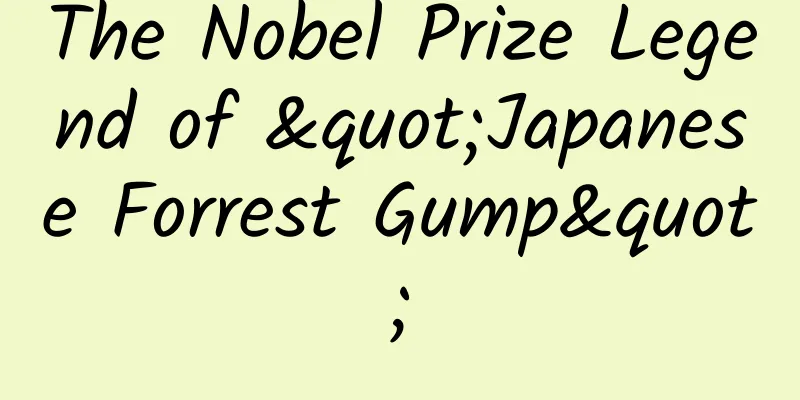The Nobel Prize Legend of "Japanese Forrest Gump"

|
This is the first Chinese popular science article published by the author in traditional paper media. I was fortunate to cooperate with the Shanghai-based bimonthly Science in 2005. Over the years, this article has received good responses from readers on the Chinese Internet, and has been cited in blogs and WeChat public accounts until recently. When I first wrote the popular science article, I did not have the energy to consider the illustrations. Many years later, based on the experience of writing many WeChat public account articles, I feel that I can re-create this old article in a way that combines text and pictures, and through WeChat and Weibo on smartphones and other online communication channels, let more new generation science enthusiasts understand the inspiring and interesting history of science. Written by | Xu Yixun In October 2004, I attended the 3rd International Proteomics Annual Meeting in Beijing. During the poster reading time between reports at the main venue, people could always see a now well-known Japanese scientist holding a notebook and diligently extracting information like a serious graduate student. Seeing this scene, I could hardly imagine that the man in front of me was Koichi Tanaka, the 2002 Nobel Prize winner in Chemistry. I immediately thought of the nickname given to him by some commentators on the Chinese Internet, which was very appropriate - "Japan's Forrest Gump". The 1994 Hollywood blockbuster "Forrest Gump" is undoubtedly one of the few great films in the past decade, and has had a profound impact worldwide. This film features Forrest Gump, a man with congenital intellectual disabilities, as the protagonist, showing us a different perspective on the world. From Forrest Gump's perspective, the world is so simple and calm. However, it is precisely those simple things that he insists on that ultimately show a kind of tenacious and lasting power, which makes us "smart people" who have lost our way in the hustle and bustle of fame and fortune sigh. Driven by his aesthetic tendency, director Robert Zemeckis designed all kinds of hilarious good luck for Forrest Gump's life, thereby diluting the political irony in the script and making the film more like a life fable. The huge gap between Koichi Tanaka's mediocre career and his unexpected success makes him quite similar to the artistic fictional character Forrest Gump. General Engineer Koichi Tanaka is an ordinary engineer at Shimadzu Corporation, a Japanese company headquartered in Kyoto. Shimadzu Corporation is a company that produces scientific testing instruments. Professionals specializing in physics, chemistry or biology may have heard of it, but the company is only a small and medium-sized enterprise in Japan. Compared with previous Nobel Prize winners, Tanaka's resume is very ordinary and unique. He is neither a professor nor a doctor, and he does not even have a master's degree. Professor John Fenn, who shared the Nobel Prize with Tanaka for inventing the electrospray mass spectrometer (ESI-MS), was actually unaware of this and even blurted out "Dr. Tanaka" during his speech. Tanaka graduated with a bachelor's degree in electrical engineering from the Faculty of Engineering of Tohoku University. Tohoku University is a very excellent university in Japan besides the University of Tokyo and Kyoto University, and was once ranked third. Due to the limitations of his professional background, Tanaka only had the knowledge of high school chemistry when he entered Shimadzu Corporation in 1983. He probably never dreamed that he would win the Nobel Prize in Chemistry 20 years later. After joining the company at the age of 24, Tanaka devoted himself to the research work in the laboratory with great enthusiasm, and put his marriage and reputation promotion behind. We learned from his autobiography after winning the award that Tanaka did not complete his lifelong event until he was 35 years old through a marriage agency. He admitted that he was very shy and not good at speaking in front of the opposite sex. It is worth mentioning that when Tanaka won the award in 2002, Shimadzu, where he had worked for 20 years, only had a "director" title, which was only one level higher than the lowest professional title. Japanese companies usually implement a dual-track system for job promotion, which is divided into two major tracks: management positions and specialized positions (also known as administrative positions). People with a bachelor's degree are generally classified as management positions. After joining the company, you first work as a clerk for one or two years, and then you are promoted to director. There are also department heads, section heads, deputy directors, department heads, etc. Each position is often divided into 2 to 3 levels, and there are also minimum terms of service. It is reported that in order to be able to engage in research work at the forefront of the laboratory, Tanaka never seriously participated in the promotion examination. Like companies around the world, Japanese companies' salaries are also linked to positions. The amount of the annual general wage increase is very small, roughly 2% to 3% of the monthly salary. Therefore, it is no exaggeration to say that Tanaka has been indifferent to fame and fortune for almost 20 years, quietly contenting himself at the bottom of Japanese corporate society. Mass spectrometer research Tanaka has been passionate about electronic technology since he was young. When he was a child, he often enjoyed assembling radios by himself. Choosing electronic engineering as a major not only satisfied his personal interests and hobbies, but also met the employment tendency of Japanese corporate society that emphasizes practical technology. When he first joined Shimadzu, he thought he could join the medical instrument development project he longed for, but he was unexpectedly assigned to the analytical instrument development team that had been established not long ago. The members of the team were several young people in their twenties, and Tanaka was the youngest among them. Their initial project was to improve a precision laser instrument that could detect the surface structure of semiconductor metals, but after testing, it was found that the performance of the instrument did not significantly surpass similar German products that had already occupied the market, so it could not be directly launched on the market. The energetic team members were unwilling to give up easily and decided to take a different approach and try another possible use of the laser instrument - mass spectrometry analysis of biological molecules. Starting in 1984, the team members redefined the division of labor for this new project. Tanaka was responsible for studying the upstream biochemical sample preparation and ionization methods, and several other colleagues were responsible for the mass-to-charge ratio analyzer, ion monitor and mass spectrometry data system. As the saying goes, heroes are made by the times. In the "know-it-all's weapon spectrum" in the field of analytical chemistry, the mass spectrometer (MS) has gradually topped the list since the 1970s due to its unparalleled sensitivity. By the 1980s, the advanced mass spectrometers at that time could easily detect and analyze organic small molecules (molecular weight below 1000 Daltons) with concentrations as low as 10-15 moles (femtomolar), but the detection of biological macromolecules was still recognized as a super difficult problem. At that time, chemical authorities generally believed that biological macromolecules such as proteins (molecular weight above 10,000 Daltons) could not be ionized from samples without cracking and enter the gas phase required for mass spectrometry analysis. However, Tanaka's chemical knowledge at that time was very limited, and he did not understand the pessimistic views of these authoritative scholars at all. At that time, Tanaka learned from literature that a group of European and American scholars in this research field had focused their attention on the ionization method of "rapid thermal induction of molecular desorption". Their idea is that although the heated macromolecules have a higher probability of evaporating into the gas phase and being ionized, they are also prone to cleavage due to decreased stability. Therefore, the key to success lies in whether the macromolecules in the liquid phase can reach a high temperature in a very short time. Laser pulses can usually generate high energy in a period as short as nanoseconds or microseconds. This heating method is obviously a very attractive choice (Figure 1), but the difficulty lies in whether an absorption medium (matrix) can be found to efficiently convert light energy into heat energy and then transfer it to the macromolecular sample solution embedded in it. Figure 1: Laser rapid heating-induced desorption in vacuum may cause macromolecules to evaporate from the liquid phase into the gas phase, and the complete molecular ion peak is detected by time-of-flight mass spectrometry (TOF-MS). Source: https://www.nobelprize.org/uploads/2018/06/advanced-chemistryprize2002.pdf With the courage of a newborn calf and the urgency to find new uses for Shimadzu laser technology, Tanaka decided to take on the difficult task of screening absorption media. At that time, there were hundreds of media available in Shimadzu's laboratory. In the absence of an ideal laser absorption medium, Tanaka, who had extremely limited knowledge of chemistry and had never studied ionization theory, could only try mechanically day after day. He had a simple mindset like Forrest Gump and could tirelessly continue the screening work. In Tanaka's autobiography, he said, "I felt like I was integrated with the medium and the mass spectrometer." However, these heavy workloads of mechanical screening did not lead to any breakthroughs. At this time, Yoshida Yoshikazu, another member of the Shimadzu research team, suggested that he try ultrafine metal powder (UFMP, commonly cobalt powder). The diameter of these nanoparticles is not much different from the wavelength of the laser, and they can absorb light energy very efficiently, so UFMP looks black. In addition, the small distance between UFMP particles greatly reduces the possibility of heat energy being dissipated and lost. By mixing UFMP with the organic sample to be detected by the mass spectrometer, the UFMP can be irradiated with a laser to reach a high temperature in a short period of time. Tanaka has achieved a phased result by using UFMP as a medium. He successfully improved the mass spectrometry detection range of organic polymers. For example, after the polyethylene glycol (PEG) series mixture was ionized by laser irradiation alone, only polymers below 1000 Daltons could be seen on the mass spectrum, and the resolution between ion peaks of different molecular weights was poor. However, the laser irradiation mass spectrometry of PEG mixed with UFMP medium can clearly detect the 2000 Dalton series, and the peak resolution of 200, 400, 600, 1000, and 2000 series is comprehensively improved (Figure 2). The experimental results are encouraging. Unfortunately, the use of UFMP medium for the ionization of biopolymers with molecular weights of tens of thousands is still ineffective. Figure 2: Ultrafine metal powder (UFMP) comprehensively improves the resolution of polyethylene glycol (PEG) time-of-flight mass spectrometry under laser irradiation. Source: Tanaka, K. (2002) Nobel Lecture. An unexpected mistake However, Tanaka's "Forrest Gump spirit" made him unwilling to give up easily in the face of difficulties. He still had a glimmer of hope for UFMP, so he tried to suspend UFMP in different commonly used organic solvents, trying to achieve some even insignificant improvements. His research style was typical of "one-track mindedness", that is, constantly changing solvents or adjusting solvent concentrations to conduct repeated experiments, but after countless attempts, there was still no substantial breakthrough. In February 1985, Tanaka made a very basic mistake during an experiment. He originally wanted to use acetone to suspend UFMP, but he used glycerol by mistake. Readers with a little knowledge of middle school chemistry know that glycerol is a very viscous liquid at room temperature. People can apply it on the surface of the skin to prevent cracking in winter, and biologists usually use it to preserve bacteria. Therefore, glycerol is not a commonly used solvent at all, and it is completely different from acetone with a strong pungent smell! Curious readers will inevitably ask why there was a bottle of glycerol on Tanaka's laboratory table at that time? It turned out that the most popular ionization method in the mass spectrometry industry in the early 1980s was not laser irradiation, but the fast atom bombardment (FAB) method pioneered by Michael Barber and David Surman. This method requires glycerol as a medium (Figure 3). The Shimadzu research team had to use the FAB method for control experiments to develop a new mass spectrometer, so as to prove the superiority of the new method. Figure 3: Mechanism of desorption and ionization using glycerol as a medium by fast atom bombardment. Source: Tanaka, K. (2002) Nobel Lecture. When Tanaka "unfortunately" poured glycerol into the mixture of UFMP and vitamin B12 to be tested, he immediately realized this "major mistake" because such a viscous liquid could not be acetone. At that time, UFMP was relatively expensive, and Tanaka always remembered his grandmother's earnest teaching of "don't waste things casually" (which is in line with the mother's saying "life is like a box of chocolates" that Forrest Gump remembered in the movie), so he was determined to save this UFMP sample. Since the mass spectrometry experiment was carried out in a vacuum, Tanaka knew that the glycerol just added would evaporate sooner or later, and then he could "set things right" by adding acetone. But he was really anxious at the moment and couldn't stand the torture of waiting. So he used laser irradiation to try to speed up the volatilization of glycerol, and at the same time, his eyes were fixed on the mass spectrum on the display screen. As long as he could see the "unlucky" glycerol molecular ion peak with a molecular weight of 92 disappear, his "UFMP rescue plan" would be successful. But at this moment, an unexpected protonated molecular ion peak appeared in the mass spectrum, and its molecular weight corresponded to the complete vitamin B12 molecule (1315 Daltons). Figure 4: Chemical structure of vitamin B12 Although the molecular weight of vitamin B12 (Figure 4) is not particularly large, its three-dimensional structure is relatively complex, making it a legendary molecule in the history of chemistry. In 1956, British scientist Dorothy Hodgkin used X-ray crystal diffraction to solve the complete structure of vitamin B12 and won the 1964 Nobel Prize in Chemistry. This exquisite structure also aroused the keen interest of American organic synthesis master Robert Woodward. Starting in 1961, a multinational team led by Professor Woodward's laboratory at Harvard and Professor Albert Eschenmoser's laboratory in Zurich, Switzerland, worked hard for 12 years and finally completed the artificial total synthesis of vitamin B12 consisting of hundreds of reactions (Figure 5). This is a monument in the history of organic chemistry, and the theoretical breakthrough brought about by it - the Woodward-Hoffmann rule - won the 1981 Nobel Prize in Chemistry. Vitamin B12 molecules can absorb laser energy very efficiently and are easily cleaved in the gas phase. When Tanaka used the acetone suspension of UFMP as the medium, it was difficult to detect the complete protonated molecular ion peak in the mass spectrometry, but a large number of fragment ions produced after its cleavage were often seen. Unexpectedly, a miracle happened after mixing with glycerol! Therefore, we might as well humorously regard the "Gan" in Tanaka's Chinese nickname "Japanese Forrest Gump" as the "Gan" in glycerol, which has a double meaning. Figure 5: Total synthesis of vitamin B12 designed by retrosynthetic analysis. Source: Nicolaou, KC & Sorensen, EJ (1996) Classics in Total Synthesis, pp. 99-136, VCH Publishers, Inc. Tanaka, who was skeptical, began to try to use the magical UFMP-glycerol mixed medium to detect larger biological molecules. He adjusted various experimental parameters with superhuman patience, and dared to break the convention of the European and American mass spectrometry community at that time, which generally used a high-energy laser source with a wavelength of 266 nanometers. He took the lead in trying a low-energy nitrogen laser source with a wavelength of 337 nanometers, in order to avoid the strong absorption band of the aromatic amino acid side chains in protein molecules near 280 nanometers. As expected, the probability of protein macromolecules in the sample being cleaved was significantly reduced. With his tireless attention to experimental details, Tanaka finally detected the molecular ion peak of carboxypeptidase A of 34,529 Daltons in August 1985 (Figure 6)! This was a historic breakthrough in instrumental analytical chemistry, officially announcing that protein macromolecules could be completely ionized and enter the gas phase. Figure 6: Intact molecular ion peaks of carboxypeptidase detected by UFMP-glycerol mixture. Source: Tanaka, K. (2002) Nobel Lecture. It is not difficult for us to imagine Tanaka's ecstasy when he finally achieved success after countless failed experiments. However, he had the same tenacity as Forrest Gump and continued to pursue his success relentlessly. In 1987, he detected a lysozyme heptamer with a molecular weight of 100,872 Daltons (Figure 7). Figure 7: Lysozyme heptamer molecular ion peak detected by UFMP-glycerol mixed medium. Source: Tanaka, K. (2002) Nobel Lecture. Looking back, the accidental addition of glycerol to UFMP was actually a historical turning point. In the previous year, Tanaka had to face negative experimental results almost every day, and could only comfort himself by saying "I have eliminated another medium." Since realizing the wonderful use of the UFMP-glycerol mixture (Figure 8), the work of further optimizing the experimental parameters is still boring and tedious, but at this time, Tanaka can make clear and visible small progress in almost every experiment, which makes him experience unprecedented joy since he graduated from university and became an engineer. Of course, the successful development of the entire mass spectrometer is also inseparable from the concerted efforts of Tanaka's four colleagues in other links. Tanaka, who conquered the extremely difficult bottleneck, is naturally the number one contributor to the project. Figure 8: The mixed medium of glycerol and UFMP is the key technology for Koichi Tanaka to achieve the first laser desorption and ionization of macromolecules. Source: Tanaka, K. (2002) Nobel Lecture. Opportunity to win the Nobel Prize In 1985, Shimadzu promptly submitted an application to the Japanese Patent Office for Tanaka's new mass spectrometry ionization method, and the patent was approved in 1993. This was basically the end of the mission for most researchers working in the company. The next step was for the company's business development department to decide whether it was worthwhile to bring the mass spectrometer to the market. Management would consider issues from the company's interests and generally did not want its researchers to publish their results in academic journals immediately. This is why many scientists in the industrial world have outstanding results but their originality and priority are difficult to be recognized by the academic community. Academics usually do not read patent documents, not to mention that patent laws and regulations vary greatly from country to country, and the patent review system does not have a relatively unified and fair standard like the peer review system of journals. If Shimadzu's business development department believed that Tanaka's mass spectrometer had no market potential, then this achievement would have been shelved and unknown to the world, and readers would not have read this wonderful legendary story. Fortunately, Tanaka had the same unstoppable luck as Forrest Gump, and the following series of events were indispensable for him to finally win the Nobel Prize. Figure 9: Overall design of the new laser mass spectrometer developed by Shimadzu Corporation in 1987. Source: Tanaka, K. et al (1988) Rapid Commun. Mass Spectrom. 2:151–153. First, Shimadzu decided to officially launch a new mass spectrometer (Figures 9 and 12) in 1987. In order to promote the product, the company allowed five members of the R&D team, including Tanaka, to announce the results for the first time at the annual meeting of the Japanese Mass Spectrometry Society held in Kyoto in May. Their experimental results were only slightly responded to during the meeting, and most Japanese scholars were still skeptical about its practicality. Moreover, the on-site reports and poster abstracts of the meeting were all published in Japanese, which could not attract the attention of Western scholars. Then in September 1987, the Second Sino-Japanese Mass Spectrometry Symposium was held in Takarazuka, Japan. Since this was an international conference and the working language of the conference was English, it attracted some Western scholars to participate. One of the American experts attending the meeting was Professor Robert Cotter from the famous Johns Hopkins University School of Medicine. I myself had the honor of attending Professor Cotter's mass spectrometry course when I was a first-year doctoral student and benefited a lot from it. In 1987, Professor Kurt was already an authority in the field of time-of-flight mass spectrometry. In his report at the conference, he put forward a view that "the molecular weight detection range of plasma desorption mass spectrometry (PDMS) is greater than that of laser desorption ionization mass spectrometry (LDI-MS)". Tanaka, who was sitting in the audience, thought that Kurt didn't know about his research results at Shimadzu, so he invited Kurt to see his poster the next day after his report. When Kurt saw that Tanaka's LDI-MS could actually detect lysozyme heptamer, he could not hide his amazement. After obtaining Tanaka's consent, Kurt, who firmly believed that science has no borders, faxed the abstract of Tanaka's poster, the details of the ionization method, and several key mass spectra to several major mass spectrometry laboratories in Europe and the United States as soon as he returned to the hotel. It was later proved that Professor Kurt's enthusiastic publicity helped the unknown Tanaka establish the originality of his new LDI ionization method in Europe and the United States, and also inadvertently provided "noble help" to this younger scholar who did not care about fame and fortune. Finally, another Japanese scholar who attended the meeting, Takekiyo Matsuo, an assistant professor at Osaka University, reminded Tanaka several times that he must publish his research results in an English paper as soon as possible. Tanaka thought that his English level was so poor and his writing ability was even more average, but considering Matsuo's good intentions, he "reluctantly" agreed to give it a try. Tanaka, who only wanted to publish as soon as possible, didn't care about the reputation of the academic journal at all. After barely finishing the manuscript, he glanced at the list of English journals in the field of mass spectrometry. When he saw the word "fast" in the title of Rapid Communications in Mass Spectrometry, he felt that it was very appealing, so he submitted the manuscript to the journal without saying a word. Sure enough, this paper passed the review smoothly and was printed in August 1988 (Figure 10). Figure 10 Source: Tanaka, K. et al (1988) Rapid Commun. Mass Spectrom. 2:151–153. Just over two months later, two German professors, Michael Karas and Franz Hillenkamp, jointly published their independently developed new LDI method using nicotinic acid as a medium in the journal Analytical Chemistry. This method co-crystallizes the macromolecule to be measured with small organic molecules such as nicotinic acid. After continuous improvement by the German team and the test of time, it has become the basis of modern medium-assisted laser desorption ionization (MALDI) mass spectrometers due to its stronger practicality (Figure 11). However, Tanaka's method was basically ignored, and Shimadzu's first-generation MALDI mass spectrometer "LAMS-50K" only sold a pitiful one in more than ten years (Figure 12). However, the German team received a fax from Cote as early as September 1987 and witnessed Tanaka and others successfully detecting protein polymers with a molecular weight of up to 100,000 by mass spectrometry. Based on academic norms, they must cite Tanaka's conference abstract in the references of the paper (Tanaka's formal paper had not yet been printed when they submitted the paper). In the following decade or so, MALDI mass spectrometers and ESI mass spectrometers have developed rapidly and become the two mainstays in the field of biomacromolecule mass spectrometry analysis. They also provide technical support for high-throughput proteomics research in the postgenomic era of the 21st century. Figure 11: Workflow of a modern medium-assisted laser desorption ionization mass spectrometer. Source: Berg, JM, Tymoczko, JL, Gatto, GJ & Stryer, L. (2015) Biochemistry, 8th Edition, WH Freeman & Company. Figure 12: The first generation of laser desorption ionization mass spectrometer launched by Shimadzu Corporation in 1988. Source: Tanaka, K. (2002) Nobel Lecture. In October 2002, the Nobel Prize Committee for Chemistry officially announced that Professor Finn, who invented the ESI ionization technology, and Koichi Tanaka, who first realized the LDI ionization technology, would share half of the prize money for biomacromolecule mass spectrometry, and Professor Kurt Wüthrich, who used nuclear magnetic resonance technology to study the three-dimensional structure of proteins, would receive the other half. European media were all shocked by Tanaka's award. They generally believed that the inventors of MALDI should be Karas and Hillenkamp. A considerable number of European and American scholars generally only mentioned these two Germans when talking about MALDI ionization technology in their papers. Only a few more fair scholars would add Tanaka and acknowledge the status of the three people as co-initiators, but absolutely no one would mention Tanaka without mentioning Karas and Hillenkamp. The award principle recognized by the Nobel Committee is to only recognize the most original discoveries and breakthroughs in methods. They believe that the importance of "from zero to one" is far greater than "from one to one thousand". The author speculates that Tanaka's unexpected victory in the end has a lot to do with the fact that Karas and Hillenkamp's classic article quoted Tanaka's conference abstract. The two German scholars showed admirable openness and honesty in the issue of attribution of honor. In December 2001, when they were interviewed by a reporter from the special issue of the American "Analytical Chemistry" as the inventors of MALDI, they took the initiative to mention that they were inspired by Tanaka's breakthrough work in the fall of 1987 and decided to challenge the laser desorption mass spectrometry analysis of protein macromolecules again. Tanaka's award inspired researchers who did not have a higher education or worked quietly in the industry. Shimadzu's stock price rose by 50% within a month after Tanaka won the award, and sales of various mass spectrometers suddenly began to soar. Feeling guilty about Tanaka's low professional title, Shimadzu management decided to promote him several levels and set up a mass spectrometry research laboratory named after him (Koichi Tanaka Mass Spectrometry Research Laboratory). In Japanese, the specific Chinese character phrase "Mr." is generally used only to honor teachers, lawyers, doctors, writers, artists and other respected people. So at the end of 2002, Tanaka's superiors and colleagues had a new confusion - do we have to call him "Mr. Tanaka" in the future? Recommended Reading Tanaka, Koichi (2012). The Greatest Failure. Translated by Qi Geping and Li Xiaowu. Science Press. Note: A text-only version of this article was first published in the July 2005 issue of Science. Special Tips 1. Go to the "Featured Column" at the bottom of the menu of the "Fanpu" WeChat public account to read a series of popular science articles on different topics. 2. Fanpu provides a function to search articles by month. Follow the official account and reply with the four-digit year + month, such as "1903", to get the article index for March 2019, and so on. Copyright statement: Personal forwarding is welcome. Any form of media or organization is not allowed to reprint or excerpt without authorization. For reprint authorization, please contact the backstage of the "Fanpu" WeChat public account. |
>>: To challenge Einstein, only 100,000 gamers are needed?
Recommend
The mini program is launched amazingly, but why do I think it is bad?
In the early morning of January 9, the WeChat min...
「Black Hat SEO Forum」Lao Zhu SEO Amazon keyword ranking disappeared from the homepage?
【Black Hat SEO Forum】Amazon keyword ranking disap...
12 tips | Key points you need to know about creating advertising slogans
I won’t accept any gifts this year, and if I do, ...
Tik Tok short video personal IP content planning practical course, truly make it possible for ordinary people to implement it
Tik Tok short video personal IP content planning ...
Mainstream App promotion and customer acquisition channels and methods!
With the development of App development technolog...
The "Color Business Practice Course" not only teaches you how to match colors, but also covers all color issues in one go!
Course Catalog [Promotional Video] More than just ...
HTTPS for the entire site is here
Recently, when you use Baidu, Google or Taobao, h...
How to enjoy the big screen treatment of mobile games? Lebo Game Hall gives you fun
With the advent of the smartphone era, in additio...
How to write the copy for Qingming Festival?
When we think of Qingming What other associations...
YotaPhone: Learning from Xiaomi in China
During the coldest winter in China’s mobile phone...
I didn't argue with you when you called me an Oviraptor before, but what should you call me now?|BoLan Daily
If you had called me an egg-stealing dragon befor...
How much does it cost for a Fuzhou merchant to become an agent for a grain and oil mini app?
How much does it cost to be an agent for a grain ...
Breakthrough in customer acquisition for small and medium-sized enterprises: Private domain traffic methodology
Recently, in many offline retail stores and onlin...
How to write good information flow copywriting ideas? 5 creative ideas to help you get inspiration quickly!
Due to the particularity of information flow adve...
Moore: Moore's Law will be valid for another 10 years
[[133967]] Consumers who are familiar with comput...









